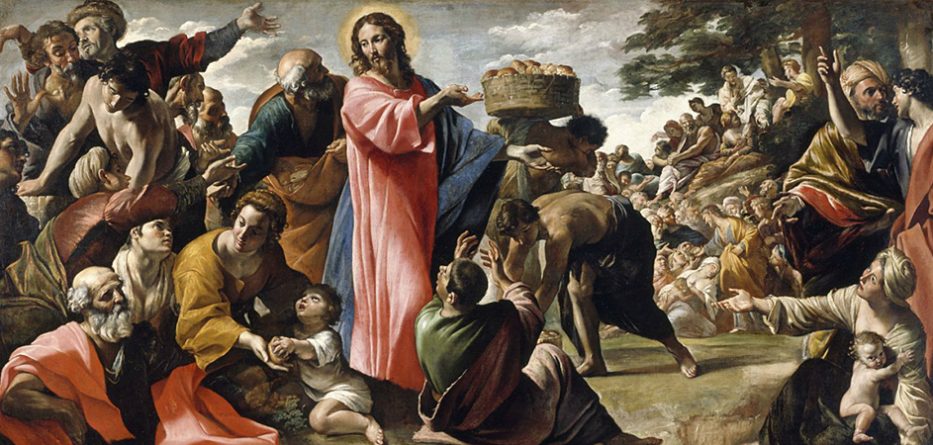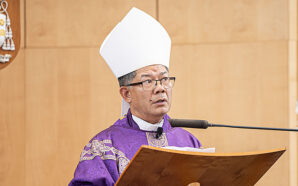The feeding of the 5,000 by Jesus at the Sea of Galilee was a precursor of the hospitality of the Eucharistic Table. How do we enliven more of our people to join, in unity, at the Sacred Banquet of the Eucharist?
This gospel about the feeding of the 5,000 at Bethsaida near the Sea of Galilee (Matthew 14:13–21; Mark 6:31–44; Luke 9:12–17; John 6:1–14) was a dramatic miracle but also a sign of the hospitality of the Eucharistic Table.
The hospitality of Jesus – whether at the marriage feast at Cana, dining with tax collectors, feeding the 5,000, most especially at the Last Supper or even at that small dinner after the post Resurrection walk to Emmaus – is a core aspect of his teaching and ministry. We share in and repeat that hospitality at every celebration of the Eucharist in which we participate.
We are guests at a sacred banquet yet in most churches we still gather like spectators in an auditorium, far removed from our host and the sacred mysteries that are celebrated – a celebration of the participants currently lined up in distributed rows in some churches spread around vast spaces.
The Second Vatican Council called in Sacrosanctum Concilium for “full, conscious and active participation” of the celebrating congregation. After significant early progress in relocating altars and adopting the vernacular, we have largely failed to meet the fundamental challenge of creating an environment where worshipers gather around the Banquet Table to fully participate in the way the Council Fathers envisioned.
Shrinking congregations
Sixty years later, we lament the drop in attendance at the celebration of Eucharist, albeit realistically accepting we live in a post secular society where religion competes with all manner of competing alternatives. We ponder the reasons for declining congregations, wonder where the young families have gone, take pride in the legacy of Catholic education, yet see few Catholic school students or their families at Mass, all while helplessly watching the decline continue. In Australia, Mass attendance is below 10% of Catholics and falling.
If we are slow to move for Christological demand, a practical need may assist. No missing Catholic challenges the sacred nature of the Eucharist, allowing of course for widely divergent understanding of the jewel of our faith, the jewel of many facets. But it is clear that more is needed to regain the attention of missing and even regular Catholics. We know that people respond to being welcomed, to feeling part of a community or organization and most particularly to having connection and a sense of unity with people, proceedings, and activities. Jesus’ prayer that “they all may be one” (John 17) is a deeply ingrained instinct in most humans.
Liturgical preparations
Many parishes go to enormous efforts to welcome parishioners, to engage with them, to give significance to the Presentation of Gifts, to offer excellent liturgy in song and ritual and to offer hospitality at morning tea and coffee. But we typically gather as observers in an auditorium like structure. We know it is not a sports game or symphony concert, but we still adopt the observer configuration in our churches. Mostly, little attempt is made to gather people around the Tables of the Word and Eucharist.
Despite their presence as invited guests at the unique and Sacred Banquet, we are content to persevere with phrasing in the Lectionary that eschews gender-neutral language and fundamentally fails to enhance connection with the Word of God or the Banquet Table. The design of many churches is claimed to militate against ready solutions, but appropriate configurations have been achieved globally, in many churches including large cathedrals.
We are locked in the days of the soccer match, patrons but observers, distant and detached, when in fact we are celebrants in the most active sense. We know people are shaped by space, yet we maintain outdated structures to keep them removed from the most sacred occasion of their daily life. Imagine having guests to dinner and sitting them at the end of the dining room. If we are really going to offer true connection, we must design and re-design accordingly.
But fostering a more connected and unifying experience with the Eucharistic Banquet could attract some, while also creating a space that shapes worshipers and fully acknowledges the intrinsic sacred nature of the action in which they participate.
Regaining lost unity
The longing of people “to regain the lost unity” that Richard Hurley, author of books on church architecture, writes about may be impeded at first by the laity being accustomed to sitting in vast pewed spaces but in my experience the first reaction to proposed change is speedily overtaken by the deep sense of unity that is experienced when they are assembled around the Lord’s Table.
Let’s recall Jesus with his disciples at the Last Supper, the early Christians celebrating the gift which Jesus gave them in their homes and in essence follow what we know so very well about hospitality – by following the example shown us by the Lord.
Let’s recover the place of the Eucharistic Table and the assembly of the people of God as active participants, led by their presider, in their joint celebration that is the source and summit of the Christian life.
Justin Stanwix is a deacon at St Mary Star of the Sea Parish, Milton in the Catholic Diocese of Wollongong (Australia) and is a regular contributor to La Croix International.
Reproduced with permission from La Croix International.








